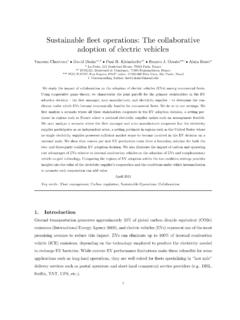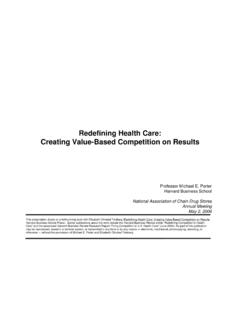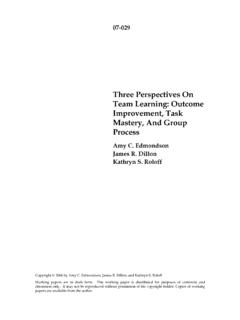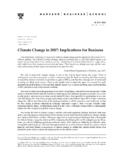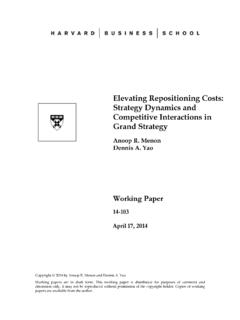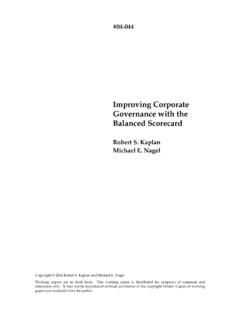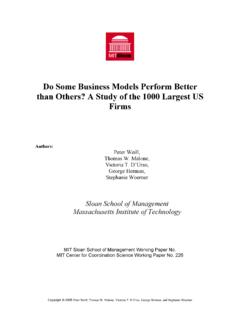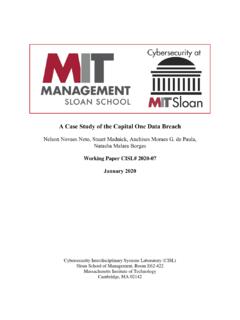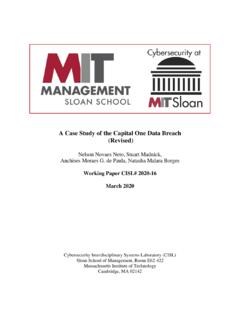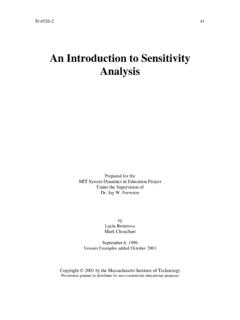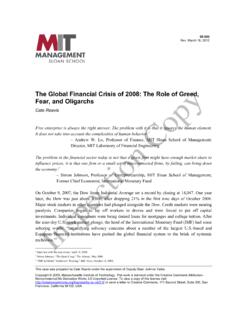Transcription of Racial Color Blindness - Harvard Business School
1 Current Directions in Psychological Science21(3) 205 209 The Author(s) 2012 Reprints and permission: : , educators, professionals, and institutions are regu-larly faced with difficult questions about how to handle issues of race in contemporary society. Concerns about being labeled racist leave many people unsure as to whether it is appropriate to notice skin Color or mention race in everyday interactions (Apfelbaum, Sommers, & Norton, 2008). Questions also emerge as to what role, if any, race should have in the develop-ment of School curricula, college-admissions criteria, promo-tion guidelines, public policy, and legal adjudication (Plaut, 2010). In this article, we examine recent evidence from a range of domains that highlights one increasingly prevalent approach to the issue of race: Color Blindness is rooted in the belief that Racial group membership and race-based differences should not be taken into account when decisions are made, impressions are formed, and behaviors are enacted.
2 The logic underlying the belief that Color Blindness can prevent prejudice and discrimination is straightforward: If people or institutions do not even notice race, then they cannot act in a racially biased manner. This notion that Color Blindness has the capacity to short-circuit the typical processes by which bias emerges was epitomized by Supreme Court Chief Justice John Roberts opinion in a 2007 case involving a local School district s efforts to achieve diversity: The way to stop discrimination on the basis of race is to stop discriminating on the basis of race (Parents Involved in Community Schools v. Seattle School District, 2007).Despite the pervasiveness of this Color -blind approach to race relations, new evidence from psychological research has called its supposed benefits into question. We document the practice and implications of Color Blindness in a wide range of contexts: interpersonal, educational, organizational, legal, and societal.
3 In each domain, despite the ubiquity of the Color -blind approach, there is mixed evidence as to its effectiveness in accomplishing intended goals. We conclude with a discus-sion of multiculturalism, a perspective that is often proposed as an alternative to Color Blindness but is not without its own Color BlindnessPerhaps the most compelling critique of the Color -blind approach is the fact that people do notice race when perceiving others. Perceptual differentiation of race occurs rapidly in less than one-seventh of a second and emerges as early as 6 months of age (Bar-Haim, Ziv, Lamy, & Hodes, 2006; Ito & Urland, 2003). Yet recent work has highlighted the prevalent tendency for people to avoid acknowledging that they see Corresponding Author:Evan P. Apfelbaum, massachusetts Institute of Technology, Sloan School of management , 100 Main St., Cambridge, MA 02142 E-mail: Color Blindness : Emergence, Practice, and ImplicationsEvan P.
4 Apfelbaum1, Michael I. Norton2, and Samuel R. Sommers31 Sloan School of management , massachusetts Institute of Technology; 2 Harvard Business School , Harvard University; and 3 Department of Psychology, Tufts UniversityAbstractIn this article, we examine the pervasive endorsement of Racial Color Blindness the belief that Racial group membership should not be taken into account, or even noticed as a strategy for managing diversity and intergroup relations. Despite research demonstrating the automatic perception of race (and thus the seeming improbability of actual Color Blindness ), the Color -blind approach to race has become increasingly prevalent in a variety of important domains, from education and Business to law and societal discourse. An emerging research literature has revealed the many ways in which Color Blindness shapes individual, group, and institutional efforts to handle issues related to diversity. We offer an integrative assessment of this work, highlighting recent psychological investigations that have explored the emergence, practice, and implications of Color Blindness .
5 We conclude by discussing alternative strategies for managing diversity and underscoring the importance of an approach that simultaneously accommodates the concerns of Whites and Blindness , diversity, race, discrimination, bias, affirmative action206 Apfelbaum et al. Racial differences during social interactions. For example, we and our colleagues (Norton, Sommers, Apfelbaum, Pura, & Ariely, 2006) presented White participants with an array of photos of people half of whom were Black and half of whom were White and challenged respondents to guess which of the photos a partner was holding by asking as few questions as pos-sible. Although asking about race was an obvious way to home in on the target photo, many participants avoided mentioning race despite knowing that their performance on the task would suffer a tendency most evident when their partner was this tendency to sidestep mention of race may stem from a well-intentioned desire to avoid bias (or at least a desire to appear unbiased), such Color -blind behavior has been found to result in various negative social consequences.
6 Ironi-cally, for example, White individuals who avoid mentioning race appear more biased in the eyes of Black observers than do White individuals who openly talk about race (Apfelbaum, Sommers, & Norton, 2008). Recent work has also suggested that, beyond efforts to avoid mention of race, deemphasizing race more broadly as an approach to Racial diversity can shape individuals attitudes toward Racial out-groups. But in this con-text, too, Color Blindness has not been an elixir to Racial bias. To the contrary, people exposed to arguments promoting Color Blindness have been shown to subsequently display a greater degree of both explicit and implicit Racial bias (Richeson & Nussbaum, 2004; Son & Shelton, 2012; Vorauer, Gagnon, & Sasaki, 2009; Wolsko, Park, Judd, & Wittenbrink, 2000), a pattern of results suggesting that a Color -blind ideology not only has the potential to impair smooth interracial interactions but can also facilitate and be used to justify Racial resent-ment (see Norton & Sommers, 2011).
7 Educational Color BlindnessThe Color -blind approach can also be observed outside of face-to-face dyadic interactions. In recent years, for instance, it has become clear that manifestations of Color Blindness cascade down various levels of the educational system. Color Blindness is reflected by the ways in which districts are per-mitted to regulate the diversity of their schools (Parents Involved in Community Schools v. Seattle School District, 2007), reinforced by standard School curricula that portray a generalized cultural identity but leave group differences unad-dressed (Schofield, 2007), and routinely exhibited by teachers seeking to model equality in their classrooms by emphasizing that race does not matter (Pollock, 2004). Consistent with these developments, evidence suggests that by the age of 10, Color Blindness becomes children s modal approach for deal-ing with race-relevant situations (Apfelbaum, Pauker, Ambady, Sommers, & Norton, 2008).
8 Recent psychological research has cast doubt on the utility of Color Blindness in educational contexts. Apfelbaum, Pauker, Sommers, and Ambady (2011) presented elementary School children with a story about a teacher who either endorsed Color Blindness or did not. Children then read about a series of schoolyard conflicts, some of which involved instances of Racial discrimination. Children who were initially exposed to the Color -blind story, compared with children who were not, were later less likely to identify bias when it had clearly occurred and tended to describe instances of discrimination in a manner that seemed less serious to certified teachers. Such findings are troubling: The fact that Color Blindness makes children less likely to identify overt instances of bias could lead people to mistakenly conclude that Color Blindness is an effective tool for reducing bias perhaps one factor contribut-ing to its continued support and proliferation in the educa-tional Color BlindnessFaced with the challenge of recruiting and managing an increasingly diverse workforce, many contemporary organiza-tions have come to endorse an internal culture of Color blind-ness (Ely & Thomas, 2001; Thomas & Ely, 1996).
9 The perceived utility of Color Blindness lies in its capacity to nor-malize employees by shifting attention from their Racial and cul-tural differences to a unifying organizational identity or goal ( , an organization may stress that employees are all the same, working toward the same goal; Stevens, Plaut, & Sanchez-Burks, 2008). Recent research has suggested that the credibility and effectiveness of Color -blind employee-recruitment efforts depend in large part on whether the organizations implementing them are actually racially diverse. For example, Purdie-Vaughns, Steele, Davies, Ditlmann, and Randall-Crosby (2008) demon-strated that minority applicants respond favorably to racially diverse organizations that endorse a culture of Color Blindness but are skeptical of such messages when they are endorsed by organizations predominantly composed of Whites. Minority applicants may have good reason to be suspicious: Organiza-tions that claim to show no Racial preference may still discrimi-nate on the basis of race and justify race-based hiring decisions under the guise of more acceptable criteria ( , Bertrand & Mullainathan, 2004; Norton, Vandello, & Darley, 2004; Pager & Qullian, 2005).
10 The implications of organizational Color Blindness for minorities who are already employed also remain unclear. Consider, for example, Plaut, Thomas, and Goren s (2009) analysis of 3,758 employees responses to a survey about the diversity climate ( , how people viewed, felt, and approached issues of diversity) at a large healthcare organization. The researchers found that White employees endorsement of Color Blindness predicted decreases in psychological engagement among minority employees and increases in minority employ-ees belief that the organizational climate was racially biased. Interestingly, they also found that White employees endorse-ment of multiculturalism an alternative approach to diver-sity in which Racial differences are acknowledged and even celebrated led to the opposite pattern of results, predicting increases in engagement and decreases in perceptions of orga-nizational bias among minority Color Blindness 207 Legal Color BlindnessColor Blindness was ushered to the forefront of legal discus-sions about race by way of decisive legislation passed during the civil rights movement.
